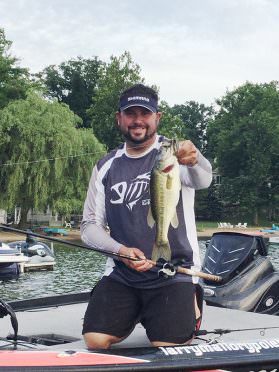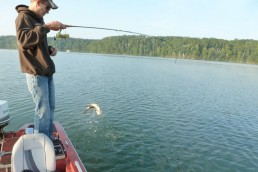Big Jigs and Texas Rigs In Shallow Water
SHARE THIS POST
If you’re a fan of Bassmasters on TV, you might have also watched one of their competitions earlier this summer as Louisiana pro Greg Hackney won a tough-bite tournament on Lake Texoma in Oklahoma. Hackney was victorious throwing a 3/4-ounce jig in the shallow waters around bushes.
The water was mostly 3 to 4 feet deep, and he didn’t have to “punch” the jig through any surface mat of algae or vegetation. The host for the BassFest tournament, Mark Zona, noted that Hackney was using the jig’s quick fall to trigger strikes from big fish. The heavy jig would zip down past the faces of bass and provoke reaction strikes from the bucketmouths tucked into the thick cover. Zona also pointed out that the big jig helped Hackney’s efficiency—its heavier weight letting it fall quickly down through the sticks and such that were in the way. Hackney didn’t have to spend time shaking the jig to get it to fall off the branches.
In much of the Midwest, especially around places where anglers are in tune with catching walleyes, most folks believe that lighter jigs are better for catching fish. Walleye guys spend a lot of time considering how to make their jigs as easy as possible for a fish to inhale and feel lighter is better.

This thinking has flopped over into bass fishing: Heavy jigs are difficult for a bass to inhale the thinking goes, so an angler ought to use the lightest jig he can get away with throwing. But in certain situations, a 3/4- or 1-ounce jig or even a 1 1/2-ounce weight in front of a Texas-rigged plastic is your best presentation.
Let’s look at when these tools and tactics can get you more action than the lighter, traditional lures.
Flipping
We already noted some of the advantages Hackney had with the 3/4-ounce jig in shallow water. One thing we didn’t mention is that a heavier jig can help your accuracy when flipping; the extra weight gives you more control as you swing it toward your target.
So the big jig goes in, sinks quickly and—if a bass doesn’t grab it instinctively on its way down—makes a thud on the bottom, even kicking up a little sediment. The jig is fast and compact on its way down, but then the bottom still shows signs of movement even though the jig itself is stationary. Something about this sudden stop and continued movement really seems to trigger strikes. Maybe the bass is conditioned to seeing a crawfish dart and then stop and it puts its claws up defensively and is further conditioned to eat the crustacean. Whatever it is, a heavy jig plopping on the bottom often gets more strikes than a lighter, slowly sinking jig that settles on the bottom. I think sometimes bass get too good of a look at something that’s sinking slowly, but just react and attack something that plummets.
In many Midwestern lakes, bass hole up in weed beds that are in deeper water than anglers will traditionally flip. We’re talking about weed patches in 6 to 14 feet of water with long, leafy weeds approaching the surface. The most efficient way to find fish in these beds of vegetation is to flip heavy jigs (or Texas-rigged worms or creature baits) into the open pockets among the green stuff. Just slowly move your boat close along the drop-off or through the weeds, looking for places to flip the jig where it won’t hit many weeds on the way down. Flip the jig in and let it sink, but be aware that a bass might grab it on its way down. If it stops too soon, set the hook; if it makes it all the way to the bottom, just lift it a couple of times. And if you don’t get bit, reel it in fast and flip it into the next opening. To be sure, wacky-rigged Senkos and other straight, sinking worms catch plenty of fish from these pockets as they sink slowly and tantalize fish, especially bass, into hitting. A jig once again plummets through the strike zone and triggers strikes. You can easily flip a jig to four different pockets in the time it takes for a Seiko to wiggle down through one. You can cover a lot more pockets with short flips using a heavy jig or the Texas rig.
Skipping
Back when skipping docks started getting popular, the thinking was you wanted the lightest jig head inside of a tube to delicately skip under piers, slowly sinking and garnering strikes. Slow-sinking stuff still catches largemouths under piers. And there are few things are more deadly than a wacky-rigged Senko that’s easy to skip with spinning tackle. Heavy jigs properly skipped not only can get a farther back under piers where only Jedi Knights can skip Senkos, but you can also get more bites and land more fish on the heavier baitcasting tackle. It takes practice, but you’ll be surprised how well you can eventually skip a 1/2- or 3/4-ounce jig with baitcasting gear, which is better for winching a big fish out from around the pier posts and over the crossbars.
Are you enjoying this post?
You can be among the first to get the latest info on where to go, what to use and how to use it!
Some may believe a lighter lure is better for skipping. It is, sort of, but not really. Wind up and whip a light tube jig or finesse worm across the water’s surface and you can get it to skip pretty far. The lighter weight keeps it from digging into the water’s surface right away. To skip a light lure very far, you have to generate a lot of speed, which means you’ve got to wind up and fling it fast and hard. Some guys get good at accurately placing light lures under docks with spinning tackle, but it takes a lot of practice.
With a heavy lure, you don’t have to wind up and generate as much speed to get your lure far under the docks. The heavier jig keeps its momentum longer, which means the jig can go just as far as a lighter lure, but with less speed and effort. Plan on backlashes when you first start trying, but eventually you’ll get the timing down, aiming, making an underhand roll cast and feathering a reel spool to avert your line from fluffing up inside the reel.
A great jig for skipping is the Denny Brauer Structure Jig from Strike King. In the 1/2-ounce size, it skips like a flat rock. It helps if you make sure the trailer doesn’t ruin the flatness of the jig’s underside that hits the water. If you put, say, a Rage Craw on as a trailer (my favorite), make sure that you impale the trailer so that the end that snugs against the jig head doesn’t create a collar that hangs down below the bottom of the jig head. If it does, the soft plastic catches the water’s surface and slows the jig down, even causing it to tumble.
The key to successful skipping is the right kind of rod. It needs to have enough backbone to pull big fish out from under the docks, but also have a tip that’s soft enough to load up and create speed for the jig as you roll-cast. Medium-heavy action rods around 7 feet long are the ticket. I have a 7-foot 2-inch Shimano Zorias baitcasting rod in medium-heavy action that does the job.
For line, I like 15- to 20-pound-test fluorocarbon. It’s tough enough and can hold up to rubbing against dock posts when a fish puts up a struggle before you can pull into more open water.
No doubt, you’ll find days when the bass want a slow-falling jig or wacky worm and won’t hit a heavier jig. But given the fact that you can move and cover more water with a heavy jig, it’s usually a good idea to start with that presentation and change if it doesn’t trigger bites. However, it can often trigger quite a few, and from bigger fish.
Tournament angler and avid outdoorsman, Buck Mallory, of Lawton, Mich., is a regular contributor to MidWest Outdoors, specializing in bass fishing.
MWO
SHARE THIS POST
You may also like...
0 CommentsGreat Shallow-water Bass Action Right Now
Did you enjoy this post?
You can be among the first to get the latest info on where to go, what to use and how to use it!
Buck Mallory
Tournament angler and avid outdoorsman Buck Mallory of Lawton writes Michigan-specific bass fishing articles for MidWest Outdoors.

